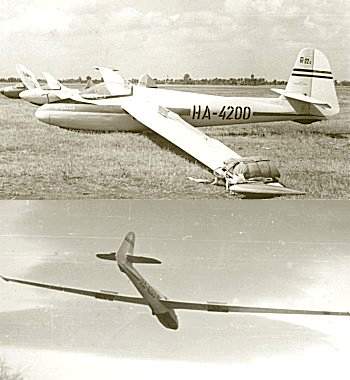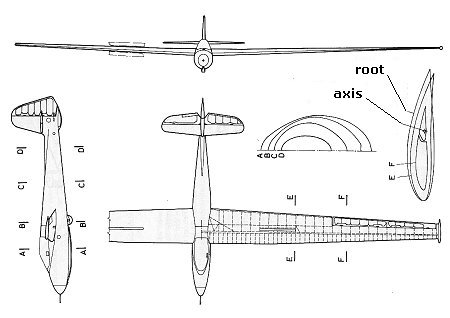HUNGARIAN
GLIDERS
1933-2000
| Type designation: |
R-22SV |
| Name: |
Super Futár (B Futár) |
| Designer: |
Ernő RUBIK |
| Class: |
High performance |
| General arrangement: |
Cantilever mid-wing, closed cockpit, fixed wheel, traditional tail unit |
| Crew: |
1 |
| First flight: |
March 1957 |
| Manufacturer: |
Sportárutermelő V., Esztergom (former AeroEver Ltd.) |
| Number of built: |
10 |

Short history:
This first version of the Super Futár series was developed from the R-22S Június-18. It could have been distinguished from the R-22S as its fuselage resembled that of the "vizes" Junius-18, and "almond" wingtip fairings were fitted. She took off first time at March 1957.
The control surfaces vere modified which resulted in better handling characteristics. The R-22SV Super Futár B was licensed for winch, high-winch and aerotow launches, basic aerobatics and cloud fying. The R-22SVs used in 1957 in an experimental wave camp were painted black around the cockpit and the double layer canopies were used.
10 R-22V B Super Futár were built.
Most memorable flights with R-22SV B gliders:
- Speed on 300 km triangle, 53,14 km/h, Ernő KISELY, 1957. National record.
- Speed on 300 km triangle, 54,96 km/h, Nándor OPITZ, 1957. National record.
- Speed on 300 km triangle, 57,91 km/h, József DOMONKOS, 1957. National record.
- 8 flights over 3000 m, 5 flights over 4000 m, 5 flights over 5000 m height gain, 1957.
- Height gain, 6659 m, Lajos LIPTÁK, 1957. National record.
- First diamond distance flown within Hungary, 509 km, Kornél THURY, 1962.
Structure: All wooden
Wing:
No flaps were fitted on this version and the wings were not foldable. The planform of the wing and the airfoils used were similar to the R-22S, but the wingtips were not rounded and "almond" wingtip fairing were fitted. To avoid an increased wing area due to the wingtip modification the span was reduced by 100 mm. These modifications did not changed the aerodynamic characteristics of the glider, in fact they improved due to the more rigid wings as the whole wing area was covered by plywood. The performance improvement was more significant at higher speeds.
Frise type ailerons were fitted. Their size were decreased compared to the R-22S and they were divided. Structurally the two parts were independent however they moved together due to the cardan joints used. The ailerons were mass-balanced.
To improve the flutter characteristics of the wings 0,5 kg balancing mass was fitted in the nose of the fuselage.
Fuselage:
The cockpit was roomier, however the adjustable seat was abandoned. The landing gear consisted of a fixed, non-brakable wheel positioned behind the c.g. and a fore as well as an aft skid both dumped by rubber-springs. On both sides of the fuselage special hooks for high-winch launches were fitted. The nose hook and these side hooks worked simultaneously.
Tail unit:
The outline of the rudder was changed and the aspect ratio of the rudder was increased compared to the R-22S. The ratio between rudder and vertical stabilizer was increased as well.
.jpg)

| Dimensions: |
| Wing: |
| Span, m: |
15,7 |
| Area, m2: |
13,5 |
| Aspect ratio: |
18,25 |
| Chord (root), m: |
1,15 |
| Chord (tip), m: |
0,45 |
| Airfoil (root), m: |
Gö 549 mod |
| Airfoil (mid-span), m: |
Gö 549 mod |
| Airfoil (tip), m: |
W-192 |
| Dihedral, degree: |
2,5 |
| Sweep, degree: |
-1 |
| Washout: |
Aerodynamic and -1,5 degree geometric |
| Aileron: |
| Span, m: |
3,36 |
| Mean chord, m: |
0,427 |
| Total area, m2: |
1,83 |
| Balancing: |
Aerodynamic |
| Flap: |
| Type: |
None |
| Airbrakes: |
| Type: |
Göppingen |
| Position (upside/downside): |
u/d |
| Total area, m2: |
0,495 |
| Position, % of chord: |
0,42 |
| Horizontal stabilizer: |
| Span, m: |
2,7 |
| Area, m2: |
? |
| Elevator: |
| Span, m: |
2,7 |
| Area, m2: |
0,75 |
| Airfoil: |
NACA 0009 |
| Balancing: |
None |
| Trim: |
Yes |
| Vertical stabilizer and rudder: |
| Total area, m2: |
1,462 |
| Rudder area, m2: |
0,711 |
| Balancing: |
None |
| Fuselage: |
| Length, m: |
6,48 |
| Width, m: |
0,6 |
| Height: |
0,97 |
| Cross section, m2: |
0,52 |
| Landing gear: |
| Type: |
Fixed |
| Wheel diameter, m: |
0,26 |
| Masses: |
| Wing, kg: |
127 |
| Fuselage, kg: |
77 |
| Tail unit, kg: |
11 |
| Empty glider, kg: |
250 |
| Gross, kg: |
340 |
| Ballast, kg: |
None |
| Wing loading, kg/m2: |
25,2 |
| Speeds: |
| VNE, km/h: |
220 |
| Max. speed with open airbrakes, km/h: |
220 |
| Max. aerotow speed, km/h: |
120 |
| Max. winch speed, km/h: |
80 |
| Max. speed in rough air, km/h: |
? |
| Stall speed, km/h: |
62 |
| Performance: |
| Min. sink, m/s (at gliding speed, km/h): |
0,67/71 |
| Best L/D (at gliding speed, km/h): |
29,5/74 |
| Start methods: |
Winch, Aerotow |

Origin of data and 3-view drawing:
Jereb Gábor: Magyar vitorlázó repülőgépek, Műszaki Könyvkiadó, 1988, Budapest
(Gábor JEREB: Hungarian Gliders, Technical Publishing House, 1988, Budapest)
Gábor FEKECS E-mail: fekecs.gabor@t-online.hu

.jpg)
